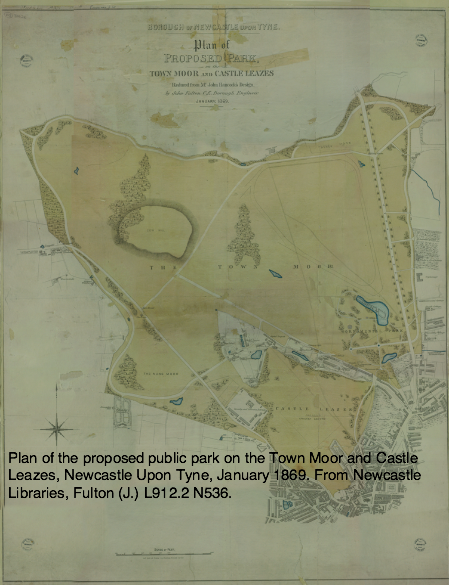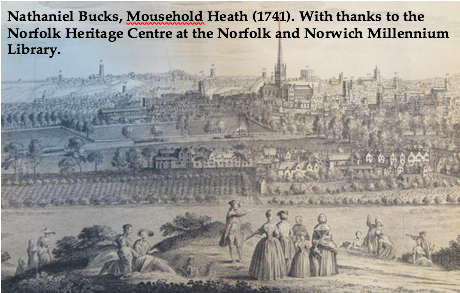People's Parks
People's Parks
With the spread of COVID-19 confining us all to our homes, the value of green space - and of access to it - has taken on new meaning and importance. Mine cannot be the only family that has come to realise in the last few weeks how lucky we are to live close to an urban park. Our regular evening walks there lift our mood and provide time for conversation and reflection after a day cooped up indoors.
The benefits of access to green space for physical and mental wellbeing have been regularly cited in the media for some years now and are acknowledged by the World Health Organisation (https://www.who.int/sustainable-development/cities/health-risks/urban-green-space/en/). Living in close proximity to such space has been linked to very specific health benefits such as the later onset of the menopause among women and better mortality rates.
Our attitude towards green space might seem very particular to the twenty-first-century, given its association with current concerns surrounding the environment, curbing obesity, and improving mental health. Yet, these modern debates are only the latest manifestation of discussions that have taken place for centuries. As far back as 1861, one Newcastle journalist wrote in words which with just minor tweaking could have appeared in today's Newcastle Chronicle:
The pure and bracing air of the Town Moor, and Leazes, so frequently
recommended by medical men to their patients for the restoration of health, and the
footpaths and pleasant walks, with liberty to stroll where you will, and not suffer
confinement to harsh gravel walks, have always been highly conducive to the
health and enjoyment of the inhabitants, who ought to be extremely grateful that
there is so large a tract of ground adjoining the town, open to them at all times for
exercise and recreation. To be deprived of it, on any pretence, plausible as it may be,
would be felt as a great misfortune ('The Corporation and the Town Moor',
Newcastle Journal, 20 September 1861).
Interestingly, this article was part of a campaign opposing the proposal by Newcastle Council to convert the city's Town Moor into a 'People's Park'. Moreover, Newcastle was not the only place in the 1860s where the idea of creating a 'People's Park' was stiffly rebutted by defenders of existing urban commons. In Norwich the proposal by the Dean and Chapter that Mousehold Heath be transformed into a 'People's Park' provoked a strong and vociferous opposition movement which held out for more than twenty years. So why did the Victorian idea of a 'People's Park' fail to appeal even to those who acknowledged the health benefits of access to open spaces? As will become clear, the issue is more complicated than it seems at first sight.
Newcastle Case
In the summer of 1861, the Town Moor Committee of Newcastle Town Council sought to make a recommendation to Parliament to convert part of the Town Moor and Leazes into a People's Park incorporating 'rides, drives, cricket and drill grounds - a gymnasium, in fact, for all classes' ('Newcastle Corporation - The Town Moor', Newcastle Journal, 8 August 1861). While the case appeared public-spirited, opponents dismissed the proposal as the latest of many attempts by the Newcastle Corporation to seize possession of land that belonged to the freemen. While not denying the positive benefits of access to green open space, not just for the freemen and their widows and orphans but for all inhabitants of the city, it was argued that 'the Town Moor, Nun's Moor, and Castle Leazes already form the most healthy and extensive public park in the north of England, and perhaps in the kingdom' ('The Corporation and the Town Moor', Newcastle Journal, 20 September 1861). Turning these commons into a People's Park, it was asserted, would be a waste of taxpayers' money.

This debate was one strand of a larger conflict between the freemen and the Corporation over the Town Moor, which had a long history. Trouble had flared in the 1770s resulting in the passing of the Town Moor Act in 1774. According to this legislation portions of the Moor could be let out for cultivation, but only under strict regulations.
At a meeting in September 1861 to arrange that year's lettings, trouble flared. Acting as a freeman and on behalf of a large group of others, the solicitor Mr E. Story entered a protest against the re-letting of the intakes which were at present under lease to tenants. Concerned at the impact repeated letting of the same intakes was having on the land, Mr Story pointed out that re-letting was contrary to the letter of the 1774 Act. When the chairman of the incorporated companies, Mr Meikle, insisted that despite the objection they should proceed to the letting, Mr Story opposed each one in turn and as a result no bids for previously cultivated land on the Town Moor were made, only the lots on the previously uncultivated Leazes being let ('The Town Moor Intakes', Newcastle Journal, 5 September 1861; 'Letting of Intakes on the Town Moor', Newcastle Courant, 6 September 1861; 'The Freemen and the Town Moor' and 'The Town Moor Intakes - Protest of Freemen', Newcastle Guardian and Tyne Mercury, 7 September 1861). At least one newspaper report in discussing the case linked the dispute to internecine conflict among the freemen, not least over rights to graze cattle on the Moor.
What appears to have been at stake in Newcastle in the 1860s, then, was not whether maintaining an area of open space close to the heart of the city was a good idea, but rather who had control over that space, how that control was to be exercised, and how the space itself should be used.
Norwich Case
In Norwich, too, the call to establish a People's Park was bound up with the issue of who controlled the urban common land, in this case Mousehold Heath, an area of heathland that had originally stretched from the edge of the city of Norwich to the Norfolk coast. By the early nineteenth century much of this area had been enclosed, but the portion closest to the city remained. On the surface this case looks very different from that of Newcastle. Rather than the city authorities seeking to seize control, the owners - the Dean and Chapter - wrote to the sheriff of Norwich in 1864 offering all rights in Mousehold to the city on condition that the area be transformed into a People's Park. In order to make sense of this apparent act of self-sacrifice and public-spiritedness on the part of the Dean and Chapter, we need to delve a little deeper. The fact that the Dean and Chapter were said to be tired of having legal responsibility for Mousehold Heath suggests that control over the commons had become a burden rather than a benefit. One reason for this can be found in council debates dating back to the late 1850s.

On 23 May 1857 the Norfolk Chronicle reported a discussion in the recent quarterly council meeting regarding the condition of Mousehold Heath. Some development of this part of the heath had begun in the late eighteenth century and by the 1850s it was a popular place for Norwich's growing middle class to walk and take exercise. One of those present at the meeting described it as 'one of the finest places in the world to gallop over' and claimed 'it renovated any one to do so'. There were, however, concerns that these activities were being negatively affected by other uses to which the heath was being put. A number of representations were made to the watch committee regarding encroachments on the heath - in particular marl pits and ditches. Concern was expressed that these features negatively affected the experience of walkers and riders, but also that they made the road 'extremely dangerous'. One council member went so far as to suggest that the activities of a few individuals were rendering the area 'entirely useless' ('Norwich Corporation', Norfolk Chronicle, 23 May 1857).
While the Dean and Chapter, the city authorities, and the middle class inhabitants of Norwich, may have been in agreement that a People's Park provided the solution to the problem of Mousehold, other users of the common were less convinced (Neil MacMaster, 'The Battle for Mousehold Heath 1857-1884: "Popular Politics" and the Victorian Public Park', Past and Present, 127 (1990), 117-154). Residents of the parish of Pockthorpe, which bordered the Heath, had long used the land for the purposes of brick making - a key local industry. It was this activity that created the pits and quarries that caused such consternation among the more well-to-do inhabitants of the area. Their claim to the land is reflected in the fact that on historic documents the area is often described as 'Pockthorpe Heath'. These residents already felt disadvantaged by the earlier enclosures and so were keen to retain rights over the heathland that remained. They were, of course, less powerful and not as well-connected as Newcastle's freemen, making it remarkable that they were able to delay Mousehold's conversion into a People's Park for more than twenty years. This achievement was largely the work of the Pockthorpe committee but, as Neil MacMaster has argued, this group benefitted from the passing of the Reform Act of 1868, which made electoral candidates reluctant to give their support to policies that were expressly opposed by the new working-class voters. In the end the case went to Chancery, where a decision was taken in 1883 in favour of the city and the creation of a People's Park.
These cases remind us that while the idea of a People's Park, and the associated drive to encourage more ordinary people to engage with the natural environment and gain the benefits of fresh air and exercise, may seem uncontroversial and self-evidently good, apparent short-term gains could be used to mask longer term losses. This might be the transfer of rights over common land to those with a vested interest in exploiting that land for profit, or middle and upper classes uses of the land trumping any claims of members of the lower orders. What these cases reveal above all else is that the control of common land is a political issue.
Dr Rachel Hammersley, Newcastle University










